Sison, Pangasinan
Sison, officially the Municipality of Sison (Pangasinan: Baley na Sison; Ilocano: Ili ti Sison; Tagalog: Bayan ng Sison), is a 3rd class municipality in the province of Pangasinan, Philippines. The town's original name was Alava. According to the 2015 census, it has a population of 47,518 people. [3]
Sison | |
|---|---|
| Municipality of Sison | |
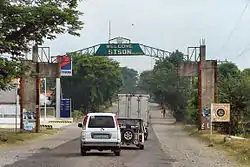 | |
 Seal | |
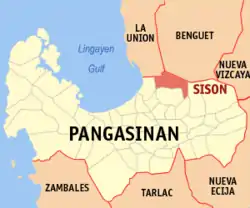 Map of Pangasinan with Sison highlighted | |
OpenStreetMap 
| |
.svg.png.webp) Sison Location within the Philippines | |
| Coordinates: 16°10′N 120°31′E | |
| Country | Philippines |
| Region | Ilocos Region (Region I) |
| Province | Pangasinan |
| District | 5th district |
| Founded | December 14, 1862 |
| Barangays | 28 (see Barangays) |
| Government | |
| • Type | Sangguniang Bayan |
| • Mayor | Danilo C. Uy |
| • Vice Mayor | Edgar M. Jovenal |
| • Representative | Ramon V. Guico III |
| • Electorate | 30,768 voters (2019) |
| Area | |
| • Total | 81.88 km2 (31.61 sq mi) |
| Elevation | 131 m (430 ft) |
| Population | |
| • Total | 47,518 |
| • Density | 580/km2 (1,500/sq mi) |
| • Households | 10,532 |
| Economy | |
| • Income class | 3rd municipal income class |
| • Poverty incidence | 10.03% (2015)[4] |
| • Revenue | ₱117,777,872.28 (2016) |
| Time zone | UTC+8 (PST) |
| ZIP code | 2434 |
| PSGC | |
| IDD : area code | +63 (0)75 |
| Climate type | tropical monsoon climate |
| Native languages | Pangasinan Ilocano Tagalog |
| Website | www |
Geography
Sison is geographically located on the northern portion of Pangasinan, bordering the provincial boundaries of La Union and Benguet. It has a total land area of 81.88 square kilometers. It is bounded on the north by Rosario (La Union), Tuba (Benguet); on the south by Pozorrubio; on the southeast by San Manuel and Binalonan; on the west by San Fabian.
The municipality is 207 kilometres (129 mi) north of Manila, 62 kilometres (39 mi) south of San Fernando City, where the regional office of the national government agencies in Region I are located, 68 kilometres (42 mi) east of Lingayen, the provincial capital, and 43 kilometres (27 mi) south of Baguio.
Barangays
| Rank | Barangay | Population | Rank | Barangay | Population | |
|---|---|---|---|---|---|---|
| 1 | Paldit | 3,630 | 16 | Pindangan | 1,416 | |
| 2 | Labayug | 2,821 | 17 | Alibeng | 1,402 | |
| 3 | Asan Sur | 2,678 | 18 | Bantay Insik | 1,345 | |
| 4 | Asan Norte | 2,191 | 19 | Agat | 1,284 | |
| 5 | Poblacion Norte | 1,987 | 20 | Inmalog | 1,244 | |
| 6 | Sagunto | 1,916 | 21 | Tara-tara | 1,205 | |
| 7 | Esperanza | 1,861 | 22 | Poblacion Sur | 1,118 | |
| 8 | Killo | 1,618 | 23 | Artacho | 1,097 | |
| 9 | Pinmilapil | 1,614 | 24 | Camangaan | 1,021 | |
| 10 | Binmeckeg | 1,587 | 25 | Bulaoen West | 1,000 | |
| 11 | Cabaritan | 1,547 | 26 | Bulaoen East | 902 | |
| 12 | Bila | 1,524 | 27 | Calunetan | 824 | |
| 13 | Cauringan | 1,509 | 28 | Amagbagan | 710 | |
| 14 | Poblacion Central | 1,478 | Sison Total | 43,979 | ||
| 15 | Dungon | 1,450 | ||||
Climate
| Climate data for Sison, Pangasinan | |||||||||||||
|---|---|---|---|---|---|---|---|---|---|---|---|---|---|
| Month | Jan | Feb | Mar | Apr | May | Jun | Jul | Aug | Sep | Oct | Nov | Dec | Year |
| Average high °C (°F) | 31 (88) |
31 (88) |
32 (90) |
34 (93) |
35 (95) |
34 (93) |
32 (90) |
32 (90) |
32 (90) |
32 (90) |
32 (90) |
31 (88) |
32 (90) |
| Average low °C (°F) | 22 (72) |
22 (72) |
22 (72) |
24 (75) |
24 (75) |
24 (75) |
24 (75) |
24 (75) |
24 (75) |
23 (73) |
23 (73) |
22 (72) |
23 (74) |
| Average precipitation mm (inches) | 13.6 (0.54) |
10.4 (0.41) |
18.2 (0.72) |
15.7 (0.62) |
178.4 (7.02) |
227.9 (8.97) |
368 (14.5) |
306.6 (12.07) |
310.6 (12.23) |
215.7 (8.49) |
70.3 (2.77) |
31.1 (1.22) |
1,766.5 (69.56) |
| Average rainy days | 3 | 2 | 2 | 4 | 14 | 16 | 23 | 21 | 24 | 15 | 10 | 6 | 140 |
| Source: World Weather Online (modeled/calculated data, not measured locally)[6] | |||||||||||||
History
Sison was once part of San Fabian until petitioners from Barrio Bolaoen signed a manifesto on June 30, 1858, expressing their intention of creating a separate pueblo.[7] It was filed to the Governadorcillo of San Fabian and was later endorsed to the Alcalde Mayor of Lingayen on August 8, 1858.[8] After the definition of the jurisdiction of the proposed new pueblo, the administrative proceedings began with the mayor of San Fabian himself, Don Enrique Casaoay, as among those who appeared in behalf of the petitioners. On December 15, 1862, a royal decree was finally issued declaring the creation of a pueblo independent of San Fabian’s civil jurisdiction. The pueblo was called Alava.[9] Don Faustino Baclit served as its ad interim head until the pueblo’s first elected president, Don Felix Genelazo, assumed his office on March 1, 1868.[10]
In 1907, Esperanza, north-east of Alava, was formed into Pinmilapil, Agat, Sagunto, Cauringan, Bila and Colisao (now in San Fabian). Labayug was formed also into Inmalog, Calunetan, San Andres, Alibeng, Bacayao and Killo. Esperanza and Labayug were joined as Artacho, its poblacion, which become a regular municipality.[11]
A bill effecting the incorporation of Artacho to Alava was approved on March 25, 1918, through the sponsorship of Senator Pedro Ma. Sison.[12][13] Following this incorporation, Alava was renamed Sison in honor of Don Perfecto Sison, first provincial governor of Pangasinan.[14]
Demographics
|
| ||||||||||||||||||||||||||||||||||||||||||||||||
| Source: Philippine Statistics Authority [3] [15] [16][17] | |||||||||||||||||||||||||||||||||||||||||||||||||
Municipal government
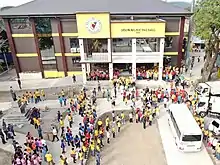
Just as the national government, the municipal government of Sison is divided into three branches: executive, legislative and judiciary. The judicial branch is administered solely by the Supreme Court of the Philippines. The LGUs have control of the executive and legislative branch.
The executive branch is composed of the mayor and the barangay captain for the barangays.[18] The legislative branch is composed of the Sangguniang Bayan (town assembly), and Sangguniang Barangay (barangay council).
The seat of Government is vested upon the Mayor and other elected officers who hold office at the Sison Town hall. The Sanguniang Bayan is the center of legislation, stationed in Sison Legislative Building or Town hall.
Specifically, Sison's mayor and Chief Executive is Danilo "Danny" C. Uy. The sangguniang bayan, the legislative body of the municipality is composed of the municipal vice mayor as the presiding officer, 8 Sanguniang Bayan Members, ABC President, and Indigenous People representative. (Section 440, Local Government Code of 1991)[19]
Tourism
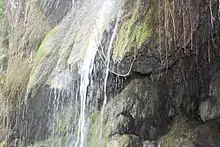
Sison has the following landmark attractions and events:
- Begnas: Sison celebrates the October Begnas festival at the New Public Market yearly with foreign residents participation (Sagada word, "thanksgiving"). National Cultural Minorities under the National Commission on Indigenous Peoples' October joined the yearly event with outsiders from Baguio City, Laoac, Pozorrubio, Bago, Kankanaeys, Ibalois and the Aplays.[20]
- 34th Eastern Pangasinan BSP Mini Jamboree
- Antong Falls
- Bued Toll Bridge (Pangasinan-La Union boundary) Gloria Macapagal-Arroyo (unveiled on June 21, 2010) the newly reconstructed three-span superstructure Bued Bridge marker in Sison, Pangasinan (destroyed by the October 2010 typhoon Pepeng) the restoration of the three-span superstructure started in January 2010(P120-million repair under the President’s Bridge Program).[21][22]
Diocesan Shrine of Our Lady of Mount Carmel
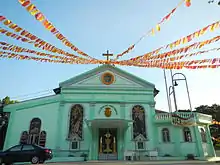
The Diocesan Shrine of Our Lady of Mount Carmel (Sison, 2434 Pangasinan) was canonically erected in 1896-1898. It is under the jurisdiction of the Roman Catholic Diocese of Urdaneta (from the Roman Catholic Archdiocese of Lingayen-Dagupan, Archdioecesis Lingayensis-Dagupanensis, created on May 19, 1928, elevated to Archdiocese on February 16, 1963, comprising the capital of the province, 2 cities and 15 municipalities in the central part of Pangasinan; Suffragans: Alaminos, Cabanatuan, San Fernando, La Union, San Jose, Nueva Ecija and Urdaneta; Titular: St. John the Apostle and Evangelist).[23][24][25][26]
The November 20, 1896 Spanish Royal Decree created Alava as a Parish of Diocese of Nueva Segovia. In 1918 the town was renamed to Sison honoring Senator Pedro Ma. Sison.
In 1928 the Parish Church was included into the Diocese of Lingayen-Pangasinan. In the 15th Centenary Anniversary of the Council of Ephesus, the Sison Parish was consecrated under “La Reina Del Monte Carmelo” (Our Lady of Mount Carmel), forming part of the Roman Catholic Diocese of Urdaneta in 1985. But it was only on its Centennial founding on November 20, 1996 that the Parish Church became a Diocesan Shrine. Its feast day is every 16 July. The Parish Priest is Rev. Fr. Bernardo Villanueva.[27][28]
Image gallery
 Municipal Library
Municipal Library Town plaza and state or auditorium
Town plaza and state or auditorium Northern Luzon Adventist Hospital
Northern Luzon Adventist Hospital Artacho National High School
Artacho National High School
References
- Municipality of Sison | (DILG)
- "Province: Pangasinan". PSGC Interactive. Quezon City, Philippines: Philippine Statistics Authority. Retrieved 12 November 2016.
- Census of Population (2015). "Region I (Ilocos Region)". Total Population by Province, City, Municipality and Barangay. PSA. Retrieved 20 June 2016.
- "PSA releases the 2015 Municipal and City Level Poverty Estimates". Quezon City, Philippines. Retrieved 1 January 2020.
- "2010 Census of Population and Housing: Population Counts - Cordillera Administrative Region" (PDF). Philippine Statistics Authority, April 4, 2012. Archived from the original (PDF) on 26 June 2015. Retrieved 16 November 2014.
- "Sison, Pangasinan: Average Temperatures and Rainfall". World Weather Online. Retrieved 31 October 2015.
- Lagmay, Dionisio (1999). History of Sison: Pueblo de Alava and the Men at the Helm. Agoo: Agoo Printing Press. p. 1.
- Lagmay, Dionisio (1999). History of Sison: Pueblo de Alava and the Men at the Helm. Agoo: Agoo Printing Press. p. 6.
- Lagmay, Dionisio (1999). History of Sison: Pueblo de Alava and the Men at the Helm. Agoo: Agoo Printing Press. p. 6.
- Lagmay, Dionisio (1999). History of Sison: Pueblo de Alava and the Men at the Helm. Agoo: Agoo Printing Press. p. 17.
- Official Website of Sison,Pangasinan
- Cortes, Rosario (1990). Pangasinan: 1901-1986: A Political, Socioeconomic and Cultural History. Quezon City: New Day Publishers. p. 20.
- Lagmay, Dioniso (1999). History of Sison: Pueblo de Alava and the Men at the Helm. Agoo: Agoo Printing Press. p. 38.
- Lagmay, Dionisio (1999). History of Sison: Pueblo de Alava and the Men at the Helm. Agoo: Agoo Printing Press. p. 38.
- Census of Population and Housing (2010). "Region I (Ilocos Region)". Total Population by Province, City, Municipality and Barangay. NSO. Retrieved 29 June 2016.
- Censuses of Population (1903–2007). "Region I (Ilocos Region)". Table 1. Population Enumerated in Various Censuses by Province/Highly Urbanized City: 1903 to 2007. NSO.
- "Province of Pangasinan". Municipality Population Data. Local Water Utilities Administration Research Division. Retrieved 17 December 2016.
- Local Government Code of the Philippines, Book III Archived 2009-03-26 at the Wayback Machine, Department of Interior and Local Government official website.
- Official Website of Sison,Pangasinan
- Official Website of Sison,Pangasinan
- "PGMA unveils the marker of the newly-reconstructed Bued Bridge in Sison, Pangasinan". Balita. 21 June 2010. Retrieved 28 September 2014.
- Morden, Johanna (21 June 2010). "Arroyo reopens major bridge in N. Luzon". Philippine Daily Inquirer. Archived from the original on 6 October 2014. Retrieved 28 September 2014.
- "Dioceses in the Philippines: Archdiocese of Lingayen-Dagupan". Claretian Publications. Archived from the original on 2 February 2014. Retrieved 28 September 2014.
- "Diocese of Urdaneta". Catholic Hierarchy. Retrieved 28 September 2014.
- "Diocese of Urdaneta". CBCP Media Office. Catholic Bishops' Conference of the Philippines. Retrieved 28 September 2014.
- "List of Parishes of the Roman Catholic Diocese of Urdaneta". Philippine Churches. 26 June 2012. Archived from the original on 6 October 2014. Retrieved 28 September 2014.
- "Shrine of Our Lady of Mt Carmel/ Our Lady of Mt Carmel Parish/ The Church of Sison (Sison, Pangasinan)". Pinoy Churches. 23 September 2012. Retrieved 28 September 2014.
- "Our Lady of Mt. Carmel Parish". Wikimapia. Retrieved 28 September 2014.
External links
| Wikimedia Commons has media related to Sison, Pangasinan. |
| Wikivoyage has a travel guide for Sison. |
